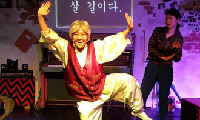Introduction:
Gwanbuk-ri Relics and Busosanseong Fortress (Historic Site No. 5) is a mud fortress located on top of Busosan Mountain (alt. 106m) in the northern part of Buyeo. The fortress is estimated by some to have been built around 538 AD (16th year of King Seongwa
Directions [Bus] From Seoul Nambu Bus Terminal, take an intercity bus to Buyeo Intercity Bus Terminal. - Take a taxi to Busosanseong Fortress (5min).
Tel:
• 1330 Travel Hotline: +82-2-1330
(Korean, English, Japanese, Chinese)
• For more info: +82-41-830-2880
Information:
Gwanbuk-ri Relics and Busosanseong Fortress (Historic Site No.
5) is a mud fortress located on top of Busosan Mountain (alt.
106m) in the northern part of Buyeo.
The fortress is estimated by some to have been built around 538 AD (16th year of King Seongwang) to protect Sabi (now Buyeo), which was once the capital of the Baekje Kingdom.
Other historians, however, believe that the fortress was already in place by 500 AD (22nd year of King Dongseongwang) and modified in 605 (6th year of King Muwang) into the structure we see today.
In either case, some parts of the fortress were reconstructed during the Unified Silla Kingdom period (676-935 AD) and modified again in the Goryeo (918-1392) and Joseon (1392-1910) eras.
Busosan Mountain was once considered the guardian mountain of Buyeo and is home to historic landmarks from the Baekje Kingdom (18 BC-660 AD).
In addition to Busosanseong Fortress, some of the most famous sites on the mountain include Baekhwajeong Pavilion, Sajaru Pavilion, Banwollu Pavilion, Yeongillu Pavilion, Samchungsa Shrine (dedicated to three loyal subjects of the Baekje Kingdom), Gungnyeosa Shrine, Goransa Temple, Gunchangji (military warehouse site), and Suhyeoljugeoji (site of pit houses for the Baekje soldiers).
The mountain is also home to Nakhwaam Rock where, according to legend, 3,000 women of the Baekje Kingdom threw themselves into the river below after the collapse of the empire. Historic Sites of Busosan Mountain■ Samchungsa Shrine Samchungsa Shrine is just a short hike from Sabimun, the main gate of Busosanseong Fortress.
The shrine holds the portraits and memorial tablets of Seongchung, Heungsu, and Gyebaek, who were known as the three most loyal subjects of the Baekje Kingdom.
Memorial services are held for these great patriots during the annual Baekje Cultural Festival each October. ■ Yeongillu Pavilion Yeongillu Pavilion was built on the site of Yeongildae, an observation platform located on the easternmost peak of Busosan Mountain.
Kings and members of the royal family of the Baekje Kingdom once used this spot as a place from which to watch the sun rise above Yeoncheonbong Peak on Gyeryongsan Mountain, plan state affairs, and pray for the peace of the kingdom and their subjects. ■ Gunchangji Also known as “Mallichang,” Gunchangji is the site of a warehouse that was used to store grain for military use.
Remnants of burnt grain were discovered at the site in 1915. ■ Suhyeoljugeoji Suhyeoljugeoji, only a short distance from Gunchangji, was once the site of a pit house for soldiers of the Baekje Dynasty.
The thatched-roof pit houses that stand on the site today have been reconstructed based on historical evidence uncovered during site excavation.
Measuring 1m in depth with walls of wood and straw, the pit houses are neighbored by an exhibition hall that stands on the original excavation site.
■ Sajaru Pavilion Sajaru Pavilion, located on the highest peak of Busosan Mountain (alt.
106m), is said to represent the cosmic powers of yin and yang together with Yeongillu Pavilion in the east.
Adorned with a nameplate written by Prince Uichinwang Yi Gang (1877-1955), Sajaru commands an ethereal view of the moon and has long since been the source of poetic inspiration.
The pavilion was also the site of discovery of the famous Geumdong-seokga-yeorae-ipsang (Gilt-bronze Standing Buddha, Treasure No.
196).
■ Baekhwajeong Pavilion Baekhwajeong Pavilion, perched on the cliffs of Nakhwaam Rock, was built in 1929 by a poets’ society called Bupungsisa to commemorate the story of the famous rock.
According to the historical tale, the women of Baekje flung themselves off the cliffs of Nakhwaam to their deaths after the kingdom collapsed to keep themselves from being defiled by the men of the insurgent kingdoms.■ Gungnyeosa Shrine Gungnyeosa Shrine is located a short distance from Taejagol (Crown Prince Valley) to the northeast of Banwollu Square.
Established in 1965, the shrine honors the Baekje women who leaped to their deaths from the cliffs of Nakhwaam Rock in 660 when the empire was conquered by the allied forces of the Silla Kingdom and the Tang Dynasty of China.
Commemorative rites are held at the shrine every October during the Baekje Cultural Festival.
Telephone: +82-41-830-2880
Current:
Status Historic Site No.
5 (designated on January 21, 1963) Tour Course Busosan Tapsa Road (Duration: about 2 hours)▲ Sabimun Gate (Ticket box) → Samchungsa Shrine → Yeongillu Pavilion → Gunchangji (Military Warehouse Site) → Banwollu Pavilion → Gungnyeosa Shrine → Sajaru Pavilion → Nakhwaam Rock → Goransa Temple → Gudeurae Sculpture Park▲ Gudeurae Sculpture Park → Goransa Temple → Nakhwaam Rock → Sajaru Pavilion → Banwollu Pavilion → Gunchangji (Military Warehouse Site) → Yeongillu Pavilion → Samchungsa Shrine → Sabimun Gate
Operating:Operating
Hours Summer (March-October) 09:00-18:00 Winter (November-February) 09:00-17:00 Parking Facilities Available Admission Fees Individuals: Adults 2,000 / Teenagers 1,100 won / Children 1,000 won Groups: Adults 1,800 won / Teenagers 1,000 won / Children 900 won* Group: 30 people or more* Free admission: Young children (Ages 6 and under), Seniors (Ages 65 and up), people with disabilities * Admission to Nakhwaam Rock and Goransa Temple included. Available Facilities Gudeurae Sculpture Park, Busosanseong Square Restrooms Available Parking Fees Free
Gwanbuk-ri Relics and Busosanseong Fortress (Historic Site No. 5) is a mud fortress located on top of Busosan Mountain (alt. 106m) in the northern part of Buyeo. The fortress is estimated by some to have been built around 538 AD (16th year of King Seongwa
Directions [Bus] From Seoul Nambu Bus Terminal, take an intercity bus to Buyeo Intercity Bus Terminal. - Take a taxi to Busosanseong Fortress (5min).
Tel:
• 1330 Travel Hotline: +82-2-1330
(Korean, English, Japanese, Chinese)
• For more info: +82-41-830-2880
Information:
Gwanbuk-ri Relics and Busosanseong Fortress (Historic Site No.
5) is a mud fortress located on top of Busosan Mountain (alt.
106m) in the northern part of Buyeo.
The fortress is estimated by some to have been built around 538 AD (16th year of King Seongwang) to protect Sabi (now Buyeo), which was once the capital of the Baekje Kingdom.
Other historians, however, believe that the fortress was already in place by 500 AD (22nd year of King Dongseongwang) and modified in 605 (6th year of King Muwang) into the structure we see today.
In either case, some parts of the fortress were reconstructed during the Unified Silla Kingdom period (676-935 AD) and modified again in the Goryeo (918-1392) and Joseon (1392-1910) eras.
Busosan Mountain was once considered the guardian mountain of Buyeo and is home to historic landmarks from the Baekje Kingdom (18 BC-660 AD).
In addition to Busosanseong Fortress, some of the most famous sites on the mountain include Baekhwajeong Pavilion, Sajaru Pavilion, Banwollu Pavilion, Yeongillu Pavilion, Samchungsa Shrine (dedicated to three loyal subjects of the Baekje Kingdom), Gungnyeosa Shrine, Goransa Temple, Gunchangji (military warehouse site), and Suhyeoljugeoji (site of pit houses for the Baekje soldiers).
The mountain is also home to Nakhwaam Rock where, according to legend, 3,000 women of the Baekje Kingdom threw themselves into the river below after the collapse of the empire. Historic Sites of Busosan Mountain■ Samchungsa Shrine Samchungsa Shrine is just a short hike from Sabimun, the main gate of Busosanseong Fortress.
The shrine holds the portraits and memorial tablets of Seongchung, Heungsu, and Gyebaek, who were known as the three most loyal subjects of the Baekje Kingdom.
Memorial services are held for these great patriots during the annual Baekje Cultural Festival each October. ■ Yeongillu Pavilion Yeongillu Pavilion was built on the site of Yeongildae, an observation platform located on the easternmost peak of Busosan Mountain.
Kings and members of the royal family of the Baekje Kingdom once used this spot as a place from which to watch the sun rise above Yeoncheonbong Peak on Gyeryongsan Mountain, plan state affairs, and pray for the peace of the kingdom and their subjects. ■ Gunchangji Also known as “Mallichang,” Gunchangji is the site of a warehouse that was used to store grain for military use.
Remnants of burnt grain were discovered at the site in 1915. ■ Suhyeoljugeoji Suhyeoljugeoji, only a short distance from Gunchangji, was once the site of a pit house for soldiers of the Baekje Dynasty.
The thatched-roof pit houses that stand on the site today have been reconstructed based on historical evidence uncovered during site excavation.
Measuring 1m in depth with walls of wood and straw, the pit houses are neighbored by an exhibition hall that stands on the original excavation site.
■ Sajaru Pavilion Sajaru Pavilion, located on the highest peak of Busosan Mountain (alt.
106m), is said to represent the cosmic powers of yin and yang together with Yeongillu Pavilion in the east.
Adorned with a nameplate written by Prince Uichinwang Yi Gang (1877-1955), Sajaru commands an ethereal view of the moon and has long since been the source of poetic inspiration.
The pavilion was also the site of discovery of the famous Geumdong-seokga-yeorae-ipsang (Gilt-bronze Standing Buddha, Treasure No.
196).
■ Baekhwajeong Pavilion Baekhwajeong Pavilion, perched on the cliffs of Nakhwaam Rock, was built in 1929 by a poets’ society called Bupungsisa to commemorate the story of the famous rock.
According to the historical tale, the women of Baekje flung themselves off the cliffs of Nakhwaam to their deaths after the kingdom collapsed to keep themselves from being defiled by the men of the insurgent kingdoms.■ Gungnyeosa Shrine Gungnyeosa Shrine is located a short distance from Taejagol (Crown Prince Valley) to the northeast of Banwollu Square.
Established in 1965, the shrine honors the Baekje women who leaped to their deaths from the cliffs of Nakhwaam Rock in 660 when the empire was conquered by the allied forces of the Silla Kingdom and the Tang Dynasty of China.
Commemorative rites are held at the shrine every October during the Baekje Cultural Festival.
Telephone: +82-41-830-2880
Current:
Status Historic Site No.
5 (designated on January 21, 1963) Tour Course Busosan Tapsa Road (Duration: about 2 hours)▲ Sabimun Gate (Ticket box) → Samchungsa Shrine → Yeongillu Pavilion → Gunchangji (Military Warehouse Site) → Banwollu Pavilion → Gungnyeosa Shrine → Sajaru Pavilion → Nakhwaam Rock → Goransa Temple → Gudeurae Sculpture Park▲ Gudeurae Sculpture Park → Goransa Temple → Nakhwaam Rock → Sajaru Pavilion → Banwollu Pavilion → Gunchangji (Military Warehouse Site) → Yeongillu Pavilion → Samchungsa Shrine → Sabimun Gate
Operating:Operating
Hours Summer (March-October) 09:00-18:00 Winter (November-February) 09:00-17:00 Parking Facilities Available Admission Fees Individuals: Adults 2,000 / Teenagers 1,100 won / Children 1,000 won Groups: Adults 1,800 won / Teenagers 1,000 won / Children 900 won* Group: 30 people or more* Free admission: Young children (Ages 6 and under), Seniors (Ages 65 and up), people with disabilities * Admission to Nakhwaam Rock and Goransa Temple included. Available Facilities Gudeurae Sculpture Park, Busosanseong Square Restrooms Available Parking Fees Free
Top Things to Do in Gwanbuk-ri Relics and Busosanseong Fortress of Buyeo [UNESCO World Heritage]

Where is Gwanbuk-ri Relics and Busosanseong Fortress of Buyeo [UNESCO World Heritage]
areas, Buyeo-eup, Buyeo-gun, Chungcheongnam-do
충남 부여군 부여읍 쌍북리, 관북리, 구교리 일원







Reviews (1)